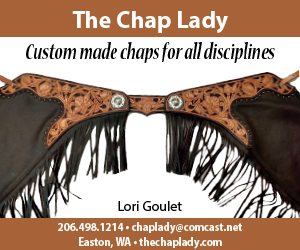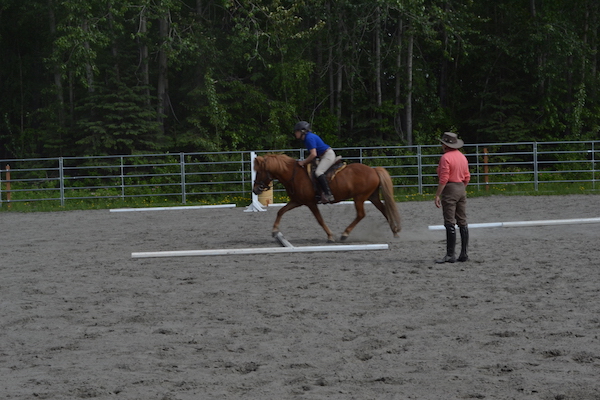Centering
by Alys Culhane
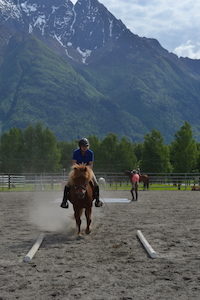
In June I organized and participated in Centered Riding clinics that spanned two weekends. Centered Riding Level Four clinicians Peggy Brown and Susan Harris and five out-of-state riders were in attendance. My Icelandic mare Raudhetta prefers arenas with obstacles so I opted to attend Brown’s Centered Jumping clinic.
Our appointed lesson time drew near. Saundra O’Reilly (an out-of-state rider) and my husband, Pete, had been working with Harris, who was conducting the concurrent Western Dressage clinic. I clipped Raudi’s lead to her halter and attempted to lead her past the indoor arena.
I say attempted because we didn’t get far. Raudi saw her stable mates Hrimmi and Tinni in the indoor arena and slammed into me with her left shoulder, knocking me slightly off-balance. I gasped as she threw her head to the right and yanked the lead out of my hand, then watched as she galloped over to Hrimmi, who greeted her with a welcoming nicker.
I retrieved Raudi, put her in the indoor arena round pen and turned my back to her. When she finally calmed down, I led her to the outdoor arena, where Peggy’s lesson was underway. Raudi stood rock still as I mounted. I grew tense when seconds later she made a beeline for the fence adjacent to the indoor arena.
Peggy, in a soft but authoritative voice, told me to go back to the four basics. My Centered Riding training then kicked in. I softened my gaze, slowed the pace of my breathing, focused on my alignment, and centered myself. Subsequently, the use of grounding enabled me to drop my weight into my legs and seat. And the use of clear intent enabled me to provide Raudi with much needed body and mind-based directives. In a voice that exuded certitude I said “Raudi, we are going down the rail.”
Peggy’s advice brought to mind the concept of centering, a Tai Chi-based concept that was made applicable to horseback riders by Centered Riding founder Sally Swift. I pictured my pelvic bowl, that is the area situated below my navel and above my pelvis. Residing within it was a slightly deflated beach ball. I made a kerplunk sound, and pictured this ball dropping into salt water. This further stabilized me. I then spun the ball forward at a moderate speed as Raudi and I trotted along the rails, and envisioned it moving diagonally as we rounded the next three arena corners.
I could have pictured my mainstays, that is a marble, tennis ball, baseball, or basketball. I instead went with this more incongruous image. I knew from having read Norman Doidge’s The Brain that Heals Itself that bringing an unusual image to mind creates new neural pathways. And the creation of new neural pathways better enables the mind to act upon the internalized request.
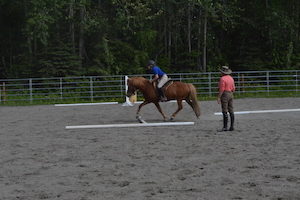
One rider was in front of us. Raudi and I maintained our distance. The lesson continued with Peggy assisting me with alignment issues. I fall forward and my heels come up when I’m nervous. Going back to center, picturing that ball, and also thinking of myself as a spruce tree growing upward and downward, put me back on the vertical. And once on the vertical, Raudi tolted. I refrained from letting out a whoop as she took up the signature four-beat gait of the Icelandic horse.
At the lesson’s end Peggy told me that prior to the lesson she’d told Pete to stand near the fence with Tinni then gradually move him out of sight. She didn’t have to add what we both knew, which was that Raudi paid the pair no mind once I was centered.
I’d presumed that in having the concept of being centered, I’d finally be one with my very willful mare. The realization that followed was that being on- and off-center is a first step in what is a much larger and more encompassing process.
I was off-center in wondering if Raudi would bolt in Tinni and Hrimmi’s direction. I was on-center in deciding to let Raudi chill in the round pen. I was on-center in taking her into the arena and mounting. I was off-center at the onset of our more formal lesson. Peggy’s directives (which were those of an experienced Centered Riding instructor) enabled me to remain on-center during the lesson.
The lesson continues. I am working at being centered now in my horsey and non-horsey doings, by noting when I am centered and when I’m not. I inherently know that being mindful, aware, and centered are well worth striving for.
Originally Published September 2017 Issue
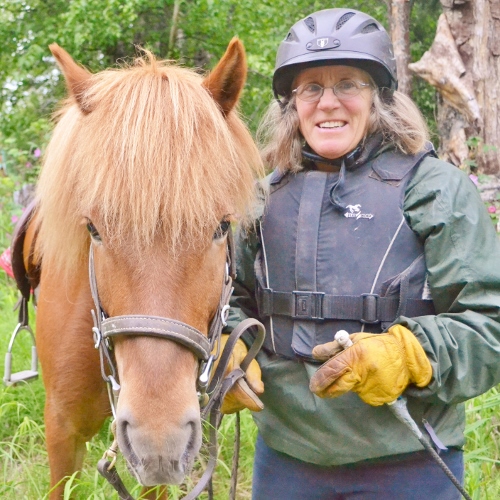
Alys Culhane is a writer and Centered Riding instructor. She and her husband Pete live in Palmer, Alaska. They share their off-the-grid place with three Icelandic horses, two dogs, two chickens, and three goats. Alys has published articles in numerous outdoor magazines and horse journals. She’s the author of Raudi’s Story: An Icelandic Mare’s first four years of life. Alys and Pete have done two lengthy, unsupported long treks on their Icelandic horses, and hope in the future to do more rides. She writes daily dispatches which she posts on her website, www.alysculhane.com.



